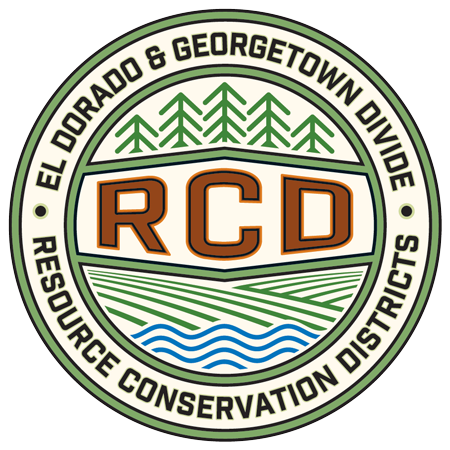South El Dorado County Fuel Reduction Project
El Dorado County Fire Safe Council (EDCFSC) and the El Dorado Resource Conservation District (RCD) are teaming up for a project called the South El Dorado County Fuel Reduction Project. This project will help to reduce fire risk and conserve our natural resources. In brief, the plan involves cutting back trees and shrubs about 50 feet from roads, but not within 100 feet of homes. Smaller trees (with a diameter of 12 inches or less) are usually removed, while some larger hardwood trees are kept. The remaining trees are trimmed and spaced out, and almost all the underbrush is removed.
Below you will find information about the project and resources for landowners.
Downloads
South County Fuel Reduction - Agreement
South County Fuel Reduction - Treatments and FAQ Download
Map Downloads
Roadside Maps
Shaded Fuel Break Maps
Roadside Fuel Reduction Treatments
The following are general prescription standards. These may be modified based on conditions or constrained by factors, including (but not limited to) sensitive biological or cultural features or where existing structures or barriers exist or prohibit access to the treatment area.
Roadside treatment areas generally extend 50 feet from the edge of the roadway, depending on vegetation type, density, and other factors.
No fuel reduction work will be undertaken within 100 feet of residential structures.
Trees 12-inch DBH (diameter at breast height) or less will be removed • Retention of selected hardwood trees (Oaks, Madrone, Big Leaf Maple) shall be maintained where feasible
Remaining trees will be limbed to no less than 12 feet above the ground, with a minimum of 33% of the crown left intact. Trees with limbs stretching over the roadway will be pruned to a height of 16 feet above the ground at the tree bole.
Spacing between remaining trees will be on average between 18-25 feet. • Ornamental trees and shrubs and landscaped areas will also not be treated (cut/removed).
Brush cover will be reduced by roughly 90% with shrub and brush cover removed, and 10% left intact for wildlife benefit. • Trees and shrubs will be masticated or cut and chipped
Depth of chips will be no greater than 4 inches.
Height of tree and brush stumps will be equal to or less than 4 inches.
Any trees or brush that are cut will be chipped on site unless the property owner requests wood be left for firewood or other purposes.
Accumulations of down and dead vegetation will be treated up to a maximum diameter of 12 inches.
Hours of operation will be limited to the hours of 7 a.m. to 6 p.m.
Shaded Fuel Break - Fuel Reduction Description
The following are general prescription standards. These may be modified based on conditions or constrained by factors, including (but not limited to) sensitive biological or cultural features or where existing structures or barriers exist or prohibit access to the treatment area.
Roadside treatment areas are located adjacent to roadside treatment areas, and have been selected for vegetation type and density, and factors such as access and strategic location
No fuel reduction work will be undertaken within 100 feet of residential structures
Trees 12-inch DBH (diameter at breast height) or less will be removed
Retention of selected hardwood trees (Oaks, Madrone, Big Leaf Maple) shall be maintained where feasible
Remaining trees will be limbed to no less than 12 feet above the ground, with a minimum of 33% of the crown left intact. Trees with limbs stretching over the roadway will be pruned to a height of 16 feet above the ground at the tree bole.
Spacing between remaining trees will be on average between 18-25 feet.
Ornamental trees and shrubs and landscaped areas will not be treated (cut/removed).
Brush cover will be reduced by roughly 90%; the majority of shrub and brush cover would be removed, with 10% left intact for wildlife benefit.
Trees and shrubs will be masticated or cut and chipped
Depth of chips will be no greater than 4 inches.
Height of tree and brush stumps will be equal to or less than 4 inches.
Any trees or brush that are cut will be chipped on site unless the property owner requests wood be left for firewood or other purposes.
Accumulations of down and dead vegetation will be treated up to a maximum diameter of 12 inches.
Hours of operation will be limited to the hours of 7 a.m. to 6 p.m.
Frequently Asked Questions
What Happens to the cut material (small trees, limbs, and brush)?
Chipping or mastication will leave the material on site, in a mulch form. The mulch is good for limiting regrowth, cycling nutrients back to the soil, trapping moisture in the soil, and limiting fire spread. Wood too large for chipping or mastication will be left on site.
What if my neighbors don’t want to participate? Will my property still be included?
Involvement by less than 100% of the property owners in a road segment or area will not exclude an area, but if the purpose of the grant can’t be met with the remaining untreated properties, adjustments may be necessary.
I have a couple of shrubs along the road I want to keep, and I have a special tree that is less than 12”dbh that I also don’t want removed. How do I make sure it isn’t cut so I can still participate?
No landscaped or ornamental trees or shrubs will be cut, and flagging can be used within reason to mark ‘leave’ trees or shrubs that would otherwise be removed. Keep in mind that significant deviation from the prescription could nullify the intended benefits of the work and participation in the project





